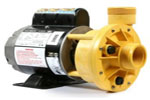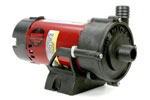Replacing a Hot Tub Circulation Pump
Spa circulation pumps are low flow, single speed pumps that run 24 hrs to keep your water filtered and heated. They run all the time, but are low energy use, drawing between 0.5 and 1.5 amps.
Running all the time does accelerate wear and tear, and makes the average circ pump lifespan about 7-9 years. If you need to replace a hot tub circ pump, here are the steps taken to do it yourself.
Do I need a new circulation pump?
Before you run off and buy a new replacement circ pump, you want to check a few things first, namely power and water flow. See our earlier post on circulation pump troubleshooting to see if you've checked all of the simple stuff first.
Which Circulation Pump do I need?
There are two main types of hot tub circulation pumps, high flow circ pumps and low flow circ pumps.

High Flow Circ Pumps look more like jet therapy pumps, and are often confused with such because of their size and appearance. They use a 48 frame motor, with a connected steel foot, and have 1.5" union connections. They can be 115V or 230V, but only use up to 1.5 amps. The most common high flow circ pumps are the AquaFlo Circmaster and Waterway Iron Might, shown here.

Low Flow Circ Pumps look more like large aquarium pumps, and operate in the 6 to 15 gpm range, to work with low flow spa heaters. They have hose barb connections to fit to 3/4" or 1" flexible hose, with clamps. They can be 115V or 230V, and less than 1 amp. The most common low flow circ pumps are made by Laing, Grundfos and Waterway.
The circulation pump that you need, is the exact replacement, in voltage, amperage and hose or pipe connection type and location. High flow pumps can be center discharge or side discharge, and low flow pumps can have 3/4" or 1" connections, and may have a left or right side discharge. If you need help finding your replacement, just give us a call or send an email.
Hot Tub Circulation Pump Replacement
1. Shut off the Power: Hit the main breaker or cut-off switch to kill all power coming into the spa pack. Wires will be exposed and water will spill, so don't take any chances and play it safe. If water splashes on any circuitry or wire connections during the process, take the time to dry it up before energizing the spa.
2. Shut off the Water: Most circ pumps don't have isolation valves on either side; slice valves that can be closed to shut off water, although common on jet pumps and on high flow circ pump systems. You can drain the spa to make the repair, if you need to drain anyway, but it's not necessary. The hoses can be plugged using wine corks or stoppers, or pinched using large needle nose locking pliers (Vice-Grip type). Or you can do a quick swap, described below, and spill a few gallons.
3. Wiring the Circ Pump: Circ pumps don't usually come with a new power cord, so you'll use the existing one. If you have a plug-in type of connector at the end of the cord, disconnect it from the spa pack. If the power cord runs directly into the control box and connects to terminals, leave those connections intact, and remove the wires only from the back of the existing motor - or you can just cut the wire where it enters the old motor, strip back the casing and the ends to put into the new motor. Insert the wires into the new circ pump, tighten the cord collar or strain relief where the cord enters the motor, and insert the stripped wire ends into the spring loaded tabs. The black wire will plug into L (Line), white wire will connect to N (Neutral), and the green wire goes to G (Ground). Disconnect the bare copper wire that is connected to the outside of the old motor, this is the bonding wire, that you'll connect to the new pump once it's in position.
4. Plumbing the Circ Pump: For very old and crusty connections, a heat gun or hair dryer can be used to soften the vinyl hose or tubing, which makes it easier to remove from the pump without a lot of pulling and jerking. The circ pump is also likely screwed into the base of the equipment bay, remove the screws in the pump base, and set aside to use later on the new pump.
Since there commonly are no cut-off valves on either side of a low flow circ pump, if your spa is full of water you will spill some water while installing a new circ pump. As mentioned above, if the spa is full of water, you can crimp the hose with locking needle nose pliers, or plug the hoses with corks until you are ready to switch, or if you have snipped off the power cord and reinstalled into the new pump already, you can make a quick swap, and spill just a few gallons.
Loosen the hose clamp and slide it down the hose. I usually pop off the top (discharge connection) first and cork it, then separate the incoming hose from the front center and very quickly swap pumps and insert the incoming hose over the front center hose barb. Then the top discharge hose can be unplugged and connected, also quickly, with minimal water loss.
If you have a high flow circ pump or a Waterway Tiny Might pump, you will loosen the unions and quickly make a swap with your new pump, being sure that the union o-rings stay in place while tightening up the union nuts.
Finishing Up: Now that you have reconnected the hoses on your pre-wired pump, the only things left to do is reconnect the bare copper bonding wire to the lug on the new circulation pump, and replace the screws to secure the pump, to reduce vibration. That, and testing your new circulation pump, followed by a hearty self-congratulation for diagnosing and fixing your hot tub problem!